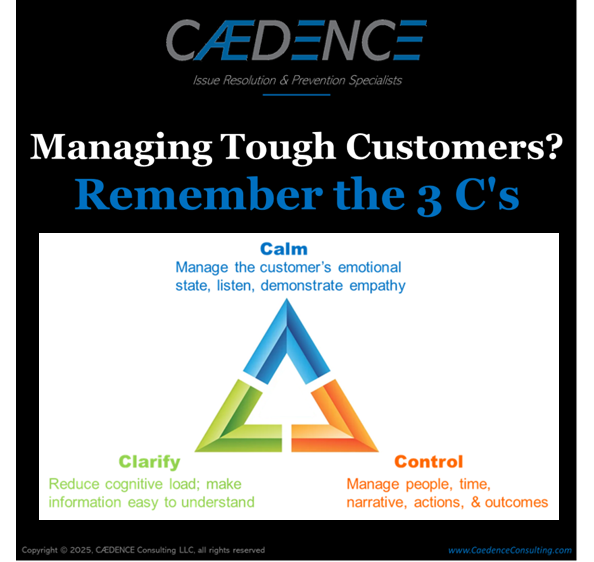What’s the Nuanced Formula for Managing Tough Customers?

When customer tensions rise, the right approach can turn friction into collaboration. At CAEDENCE, we call it the 3C’s: Calm, Clarify, Control. Here’s how each pillar elevates your customer communication and accelerates issue resolution.
1. Calm the Emotional Charge
- Listen Actively, mirror their concerns, and pause before responding.
- Demonstrate Empathy “I can see why this impacts you; that matters to us.”
- Ground the Conversation: Keep your tone steady and focused on solutions, never defensiveness.
2. Clarify to Reduce Cognitive Load
- Simplify Complex Information: Break data into bullet points, diagrams, or simple analogies.
- Confirm Understanding: Ask, “Does this make sense?” and invite questions.
- Align Expectations: Restate agreed priorities before moving on.
3. Control the Path to Resolution
- Define Clear Roles and Next Steps: Who does what by when? Spell it out.
- Schedule Actions: Set realistic deadlines and checkpoints.
- Guide the Narrative: Recap decisions, document commitments, and share updates promptly.
Mastering these 3 pillars transforms customer conflict into lasting trust. Which “C” do you rely on most when conversations get tough?

Over the years we’ve been exposed to Six Sigma, Juran, Deming PDCA, 8D, Dale Carnegie, A3, Shainin, and more. Each technique works pretty well, and has been demonstrated many times in a wide variety of industries and circumstances. At the core they are all essentially the same!
Each approach relies on an underlying logical flow that goes like this: [a] make sure the problem is clearly defined; [b] be open to all sources of information; [c] vet the information for relevance and accuracy; [d] use the process of elimination to narrow down all possible causes to the most likely few; [e] prove which of the suspects is really the cause of the issue; [f] generate a number of potential solutions; [g] evaluate the effectiveness, feasibility and risk of the potential solutions; [h] implement the winning solution(s); and [i] take steps to make sure your solution(s) don’t unravel in the future.
The differences between the paradigms resides in supplementary steps and toolkits. For example, 8D contains the important “In

Your primary role as a manager is to ensure your team’s success. Internalize this. Make sure your team members know this. Build an environment of trust and collaboration. A direct report of mine would frequently leave me out of the loop as problems escalated, preferring instead to “work harder”. It was clear that he felt uncomfortable delivering bad news to me (his boss) when things were not going according to plan. Let me tell you the rest of the story.








